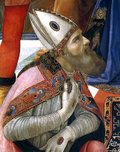
May 27 - Eastern Orthodox Church calendar - May 29
All fixed commemorations below celebrated on June 10 by Orthodox Churches on the Old Calendar. [note 1]
Contents
- Saints
- Pre-Schism Western saints
- Post-Schism Orthodox saints
- New martyrs and confessors
- Other commemorations
- Icon gallery
- Notes
- References
- Sources
For May 28th, Orthodox Churches on the Old Calendar commemorate the Saints listed on May 15 .








